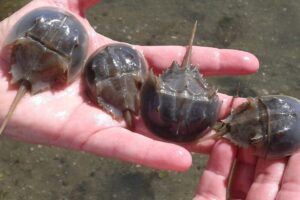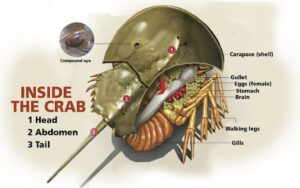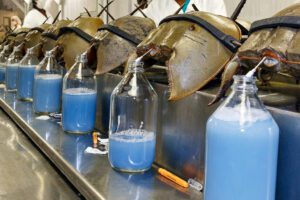Issue 4 | June 2022 | Dear Shark | Horseshoe Crabs

Dear Shark,
Why do we see so many Horseshoe Crabs along the shoreline in the summertime? And what role do they play in our local environment and ecosystem?
Sincerely,
Curious Chesapeake Bay Friend
Answer provided by Bryan Gomes, ClearShark H2O Education Coordinator
Dear Curious Chesapeake Bay Friend,
Horseshoe Crabs, often called a “living fossil”, have ancestry that goes back to the days of the dinosaurs – over 300 million years ago! And despite their name, Horseshoe Crabs are not true crabs or crustaceans, but most closely related to spiders and scorpions. Horseshoe crabs were originally called “horsefoot crabs” coined by a British naturalist in the late 1500s. This is most likely because the crab resembles the shape of the foot of a horse. Over the years the name horsefoot morphed into horseshoe, the name that it is known by today.
There are 4 species of Horseshoe Crabs worldwide but only one species calls our Atlantic seaboard and estuaries its home, Limulus polyphemus. Found from Maine to Mexico, these aquatic critters spend their days along the bottom of our waterways and in the winter will burrow into the bottom layers of mud and sediment.
 With the arrival of spring and longer, warmer days, horseshoe crabs begin to move toward the shorelines to spawn. Mating activity is heavily concentrated in our mid-Atlantic region, with the Delaware Bay being the epicenter for visitors and scientists to see this annual gathering. Between the full and new moons of late May to early June are when millions (“yes, literally millions“) will appear on the Chesapeake and Delaware Bay beaches.
With the arrival of spring and longer, warmer days, horseshoe crabs begin to move toward the shorelines to spawn. Mating activity is heavily concentrated in our mid-Atlantic region, with the Delaware Bay being the epicenter for visitors and scientists to see this annual gathering. Between the full and new moons of late May to early June are when millions (“yes, literally millions“) will appear on the Chesapeake and Delaware Bay beaches.
Like true crabs, horseshoe crabs must shed or molt as they grow over their lifetime. Similar to a true crab, horseshoe crabs shed their old shell to reveal a soft, new shell which is about 30% bigger than before. It takes about 24 hours for this new shell to harden back to the exoskeleton that protects the animal from predators
Native Americans were the first to recognize the importance of utilizing the horseshoe crab. Indigenous people ate the meat and eggs found in the animal. They used the big, oversized shell to bail water from their boats and used the tail point of the animal as a spear tip. The Native Americans also taught the colonists that horseshoe crabs could be used as a fertilizer for their crops. Some farmers even used horseshoe crabs as feed for their pigs and chickens.
There is also a strong connection between the mating season of horseshoe crabs and the migration patterns of many shorebird species that stopover in the  Mid-Atlantic to feed on horseshoe crab eggs in the late spring as they are traveling north to Arctic nesting and breeding grounds. With continued climate change and the use of horseshoe crabs in biomedical research, their numbers have declined in recent years. This has a causal connection to the food source (their eggs) that are available to these migrating sea birds. Less food available means less birds can make these long and strenuous journeys that span hundreds if not thousands of miles.
Mid-Atlantic to feed on horseshoe crab eggs in the late spring as they are traveling north to Arctic nesting and breeding grounds. With continued climate change and the use of horseshoe crabs in biomedical research, their numbers have declined in recent years. This has a causal connection to the food source (their eggs) that are available to these migrating sea birds. Less food available means less birds can make these long and strenuous journeys that span hundreds if not thousands of miles.
Although horseshoe crabs look intimidating and can grow to about 2 feet in length, they are harmless to humans. The long telson or spike-like tail is not poisonous. It is an extension of its body that the animal uses as a lever to right itself if overturned by waves, predators or curious humans. Also the claws of these animals are not sharp and do not hurt like the pinch of a blue crab. If you come across a live one on the beach, gently pick it up by its shell, holding it like a bowl, and put it back into the water. Let’s be sure to do our part so these fascinating creatures can continue to exist for millions of more years to come.
 Further Reading: the continuing debate on the use of horseshoe crabs, please click here.
Further Reading: the continuing debate on the use of horseshoe crabs, please click here.
Thanks for reading.
Sincerely, Shark
Have a question…we have the answer! Send us an email on it and what you want to know more about?

